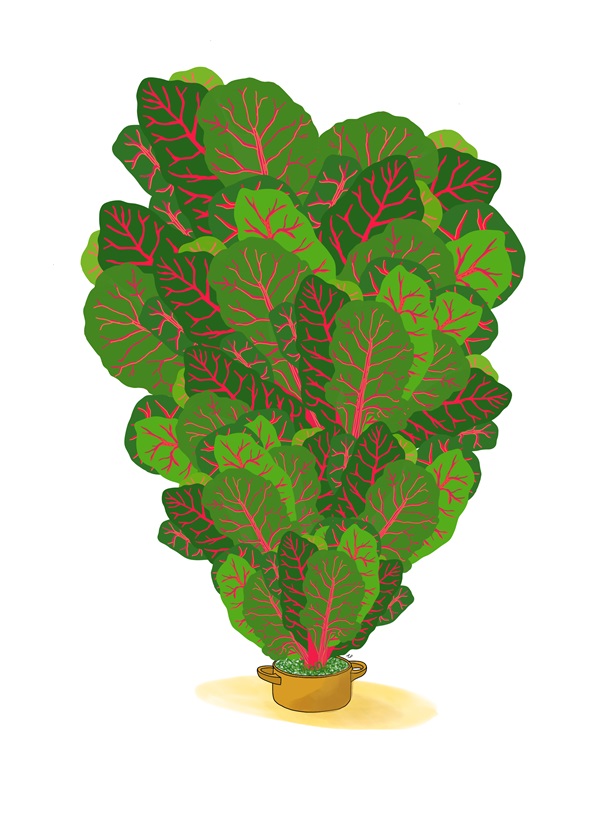You know how it is with cookbooks. There are certain ones you delve into over and over again, becoming friends with the authors as they tell you about their favorite ingredients, how they stock their pantries, how to freeze herbs, how to properly store avocados, the easiest way to grate ginger. When I was first learning to cook, one book I relied on that way was The Fresh and Green Table (Chronicle Books, 2012) by Martha’s Vineyard cook Susie Middleton. It’s full of vegetable-centric main dishes, and I owe my baked pasta, peanut noodle salad, harvest chili, roasted winter veggie tart, and potato galette to it. My very favorite recipe in the book is in the section on galettes, gratins, and tians: Individual Swiss Chard Gratins with Garlic Cream.
Middleton starts off her recipe description: “Everybody loves a mini, and a mini gratin is no exception.” Well, yes, I liked small things, and I found the picture of these perfectly browned gratins in little round dishes quite appealing. What, however, was Swiss chard? This was my first introduction to what would become my favorite leafy green.
Swiss chard is a biennial plant in the beet family. Despite the misleading name, it does not hail from Switzerland but instead was described by a Swiss botanist and thus adopted the nationality. It is grown for its stems and leaves, both of which are large and sturdy. If you happen upon “rainbow chard,” the veins and stems will be a beautiful array of reds, pinks, yellows, and oranges. The taste is mild — stronger than spinach but nowhere near as strong as kale — and it is very nutrient dense.

My first foray into the land of chard was not all rosy. I was a novice, so when I pulled the required three large bunches of chard from the fridge and piled them on my counter, I was overwhelmed. There was absolutely no way all of it was going to fit into four small ramekins. My pasta pot wasn’t even big enough to cook it all. It was going to take so long to rinse! And what was I going to do with those stems?
Nothing was on fire, but standing alone in the kitchen looking at that mountain of greens felt like a crisis. What had I gotten myself into? I didn’t even know if I liked the stuff. Probably I needed a snack. Low blood sugar is not a good idea when tackling a chard mountain.
I pushed through with the help of my mother, who came home from work just in time to help me tackle the large leaves and make the bechamel, crumbled bread, and grated Parmesan. In the magic way of green leafy vegetables, the chard shrank like Alice did when she took that potion — every bit fit into those little ramekins.
The result: an elegant-looking, creamy, garlicky, warm base of greens, topped with crispy cheese, breadcrumbs, and herbs. I became a fast fan of chard, and I have never again felt overwhelmed by this versatile vegetable. I started growing it in my garden, and although the first time I made these gratins with an armload of homegrown chard was a very happy day, I also learned you don’t have to be fancy with it. I drop chopped chard into scrambled eggs or soups as a replacement for spinach, kale, or collards. It’s excellent steamed and topped with some toasted seeds or nuts.
This gratin recipe doesn’t call for the stems, only the leaves. I usually use the stems, even when recipes say not to, because they are tasty and full of nutrition. Here, however, you want that silky, creamy filling, and crunchy stems would get in the way. But please don’t throw those beautiful things away: you can roast them tossed with olive oil, salt, and pepper or add them to soups, a stir fry, or a rice bowl.
Susie Middleton’s original recipe uses a luxurious bechamel sauce with whole milk, cream, and white flour. Since I can’t eat those things, I have adapted the recipe to be vegan. I’m happy to say it is still delicious, but if you want to use a more traditional white sauce, go ahead.
I like the color and flavor combination of serving these with a carrot salad or some roasted orange vegetables. The gratins are also excellent with a poached egg on top for a special breakfast.
INDIVIDUAL SWISS CHARD GRATINS
Makes 4 gratins
1½ Tbsp. butter or coconut oil, plus more for greasing dishes
2/3 cup breadcrumbs (gluten-free if needed)
Generous 1/3 cup grated Parmesan (or 2 Tbsp. nutritional yeast or vegan cheese)
¼ cup chopped parsley
1 Tbsp. extra virgin olive oil
2¾ lb. Swiss chard (three good-size bunches), stemmed and rinsed
2 cloves garlic, peeled and smashed
1¼ cup cashew milk
1½ Tbsp. oat flour
¼ tsp. balsamic vinegar
Salt and pepper to taste
- Preheat oven to 375° F. Rub the inside of four 8- to 10-ounce ramekins with coconut oil or butter and place them on a parchment lined baking sheet.
- Make the topping: In a bowl, stir together the breadcrumbs, 1 tablespoon of the Parmesan (or 2 teaspoons of the nutritional yeast), parsley, 1 teaspoon of the olive oil, and a pinch of salt. Set aside.
- Make the filling: In a large pot, heat the remaining olive oil over medium heat. Add the chard and ¼ tsp salt. Stir and flip the chard until the leaves have wilted, about two minutes. You may need to do this in batches if your pot isn’t very large. Transfer the cooked chard to a colander and let it drain while you make the sauce.
- In a saucepan, bring the garlic and cashew milk to a boil. Remove pan from the heat immediately and let it sit for at least 10 minutes to let the garlic infuse. Remove the garlic, pressing it against the side of the pan with a fork to squeeze out the juices.
- In another saucepan, heat the coconut oil or butter. Once hot, whisk in the flour and continue whisking until well blended. Remove from the heat. Stir in a half teaspoon of salt, the balsamic vinegar, and a few grinds of pepper. Return the butter-flour pan to the stove over medium-low heat. Pour in the garlic-infused milk, whisking constantly. Raise the heat to medium and whisk until the mixture starts to bubble and thicken.
- Coarsely chop the cooled and drained chard and put it in a large bowl. Stir in the remaining parmesan or nutritional yeast and all of the sauce. Divide the mixture evenly between the four ramekins and top with the breadcrumb mixture.
- Bake in preheated oven for about 18 minutes until the gratins are bubbling and the breadcrumbs are browned. Cool slightly and serve warm.



